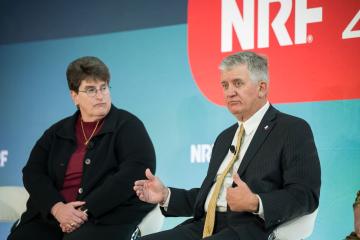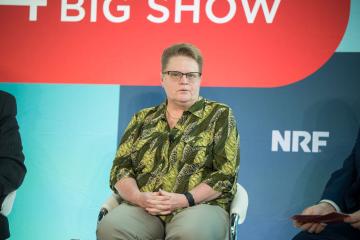
Beth Rooney, port director, the Port Authority of New York and New Jersey; Roger Guenther, executive director, Port Houston; and Debb Minskey, business developer, IKEA, speak with moderator Jonathan Gold, NRF vice president, supply chain and customs policy, at Supply Chain 360 Summit at NRF 2024.
Inconsistencies, last-minute changes, shifting dynamics and a misaligned supply chain were all hallmarks of the pandemic. Looking back, however, the importance of relationships and an increased understanding of what each part brings have also come to the surface. The season was rife with lessons, a supply chain panel said at NRF 2024: Retail’s Big Show — including the fact that things must change going forward.
Browse photos, blog posts, videos and more from NRF 2024: Retail’s Big Show.
“Weathering the storm: What’s next for U.S. ports?” was part of the Supply Chain 360 Summit at NRF 2024, taking place on the goTRG stage. Jonathan Gold, NRF vice president, supply chain and customs policy, moderated a panel including Roger Guenther, executive director, Port Houston; Debb Minskey, business developer, IKEA; and Beth Rooney, port director, the Port Authority of New York and New Jersey.
“If the pandemic taught us anything, it really gave us a glimpse into the future,” Rooney said. “We did, in 2022, the volume that we did not forecast doing until 2030.” More importantly, she added, the untenable congestion highlighted the need for change.
There’s now increased focus on understanding where cargo is going, how things operate after that cargo leaves the port, and on working with supply chain partners coming back to the complex to ensure they have the capacity within the system to meet future demand. Eventually, she said, operations will need to be 24/7.
Room for improvement
Guenther, representing the largest port in the Gulf, said his organization was prepared to handle ongoing demand from an infrastructure standpoint. As a rule of thumb, the port tries to retain at least 20% capacity for impending demand. “But what we weren’t prepared for was to get 30% in two years,” he said. “We could have handled a lot more capacity, but the problem is, containers started dwelling on our terminal.”

The port did things for the carriers, including creating a virtual queue, akin to a call-ahead notification. Even so, he agrees with Rooney: “We have to, as ports, be a bigger part of the picture.”
That includes being part of data and information; the visibility doesn’t go far enough. The port handles 1 million API connections each day with truckers, providers, logistics providers and others. “I understand there’s proprietary information of shippers,” he said. But to put things into perspective, he says the biggest commodity he has visibility into at Port Houston is 40-foot containers, “and the next largest commodity is 20-foot containers.”
When there are challenges, he said, he has no idea whose cargo is involved. He sees a lot of opportunities for improvement.
Levering the right information
Minskey, meanwhile, talked about the pandemic not only moving everything forward several years, but also moving too fast, “and not following through on all of the steps. We need to get there.”
She’s been researching ports in Europe, and learning what can be done with artificial intelligence. It’s about connecting all of the dots with the right information, understanding what’s proprietary, and bridging gaps. Without that, “we’re just hurting ourselves,” she said.
The information is there, Rooney said; it just needs to be leveraged for planning, forecasting and establishing some predictability across the entire supply chain. But she’s a little concerned that there’s so much focus on information. “We still have to physically move a box,” she said. Assets, infrastructure and people are still needed to do so.
More preparation ahead
Gold touched on the Ocean Shipping Reform Act of 2022 and the creation of the National Shipper Advisory Committee. Minskey is a member, and she said they’ve all been surprised at the lack of feedback from other beneficial cargo owners, other retailers and those in other aspects of the industry about “what to even work on.”

There’s much more the committee would like to do — especially before the next catastrophe,” she said. “We haven’t done enough in good times to prepare, and that’s what it’s going to take.”
The panelists talked about balancing the needs for growth and sustainability, as well as significant challenges for trucking; the ability to move cargo away from the terminal more quickly and efficiently; and diversification away from China.
“I wish I had a crystal ball,” Minskey said. “It used to be, maybe once a year, I’d say, ‘Wow. I haven’t seen that before.’ Now, it seems like I’m saying it at least once a week.”
The good news, Rooney added, is that the industry is “extremely resilient,” and the people supporting the industry are creative and innovative. “Whatever is thrown our way, I’m confident that we’re going to be able to handle it,” she said.


